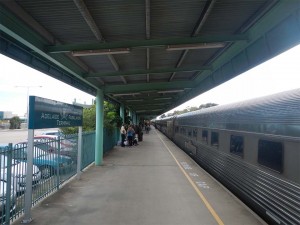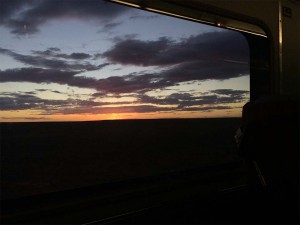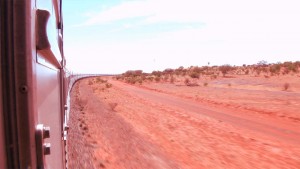When writing about our travels and experiences on our way to visit the Red Centre of Australia, I’ve referred to our arrival in our jumping off point of Adelaide as a soft landing, at least in reference to the beginning of production for the documentary. As we prepared to depart for the heart of the Red Centre, I can’t say my opinion changed much. For a city of more than a million people, Adelaide seemed surprisingly… cozy. Dropping off the rental car on the way to the train station, we couldn’t help noticing that the car had remained parked at the hotel for almost the entirety of our stay. Between the public trams and the easily accessible markets and commercial areas, most of the essentials for the itinerant traveler are well within reach. I can’t say with complete authority a car is unnecessary for an extended stay, but for what was essentially a layover, a repeat trip would have us forego the rental car.
With that, the heart of the trip was looming. This was the onset of what The Palette Project is all about – exploring the world through color – and the Great Southern Rail was getting us there. We had reserved overnight seats on the Ghan – the north/south rail line from Adelaide to Darwin. Our journey was only taking us as far as Alice Springs, but twenty-five hours seemed like more than enough time to experience Australia from the rails.

It’s always a shock to board a train and sit down for the first time. The cabins were designed in airliner fashion rather than the four seat cabins that would have had us staring at our rail mates for more than a day. Still, even though you’re looking at a layout familiar to any airline passenger, the amount of space and the comfort of the seats seemed luxurious… as did the ability to stow practically all our camera gear overhead.
As the train pulled away from the station and reached its cruising speed, it became clear this was going to be a rather sedate trip, whether we wanted it or not. The Ghan is not designed for speed. This is not necessarily a bad thing, but you should know going in that you will not set land speed records via Great southern Rail.
I can also report if you are in a mood to reacquaint yourself with not only the greatest hits of not only the 1950’s, but the 1940’s and… I’m pretty sure… the 1930’s, then the Ghan is happy to welcome you with a big musical hug. Over the course of the twenty-five hour trip to Alice Springs, I heard “The Boogie Woogie Bugle Boy From Company B” not once but three times, which effectively doubled the total number of times I had ever heard it before now. Dean Martin, Ethel Merman and Frank Sinatra are vey big deals on theGhan. I’m not judging. I’m just saying you may want o load your iPhone before you go, because there is no cell service and your free Spotify account won’t work.
Perhaps it was the intent of the route planners that the music be of a more deliberate styling, because the route certainly was. This is not necessarily bad. I was very taken with the concept of being submerged into the Australian outback. If that meant stopping overnight to park the train for more than five hours so that some of the more interesting sights railside could be observed in the daylight, so be it. There are, I note, flights to every major destination on the Ghan’s route. You take the train to see this landscape at ground level. Why cheat yourself by sleeping through it?

The dip into the Red Centre was so subtle that the better way to describe it is by referring to other senses… which in my life has been becoming more useful, anyway. I would compare it to one of my favorite homebody activities. I love making stock – almost more than I like preparing the original dishes themselves. That powerful mixture of chicken bones, carrots, celery, onions, leeks et al that results in an intoxication alchemy, but the aroma of the simmering stock as it gains potency and flavor is hard to track while you’re making it… but then you step outside to grab the mail and you come back in the house and… voila! The smell of the concoction hits you, and it’s wonderful.
The Red Centre is like that. I had been gathering clips of the view outside our window every few hours, and had been largely nonplussed. It seemed we weren’t making any progress at all. Was Uluru itself going to be my only glimpse of the deep red tinge of the outback? I knew we had been in that amorphous area known as “the outback” for hours, and the area was definitely sparse, but I wasn’t seeing it, and I wasn’t blaming the visual impairment for it either. Cueing up an audiobook to drown out the overhead speakers and the dulcet tones of Ella Fitzgerald, I ended up nodding off for a bit.
Of course, that’s when it happened. Returning to consciousness about half an hour later, I twisted the blinds to look out the window, and there it was. The most barren, amazing and red landscape I had ever seen. I know other people have made this observation before, but it was like our train had been transported fifty seven million miles to the surface of Mars. When on earth had that happened. We had been traveling through this landscape for hours and hours, but now my eyes had reset after finally stopping trying to notice the change in the environment, and now I was seeing it. Really seeing it. The Red Centre.

But not just seeing it. I am here to tell you the Australian outback has to be felt, has to be smelled, has to be tasted… yes, tasted… to be believed. It’s a flat, hanging heat that presses against your skin. You know when you’re in the outback because nothing else hits every sense you have in quite the same way.
We had been granted the privilege of access to the only car on the train with an open window in order to shoot video of the side of the train, and it afforded us an unparalleled sensory introduction to the desert. I realize how unusual it is to romanticize something as simple as dust, but the red dust of the outback has to be experienced to be believed. The dust hanging in the air found root on our clothes and under our nails,on our cheeks and on our tongues. The idea I was literally tasting Australia was big. That’s how it felt. It felt big.
Yes, Adelaide had been a soft landing. The outback was an adrenaline hypodermic. At one point, the train stopped so passengers could snap pictures of the relics left over by explorers and settlers past, and from our vantage point, our cameras and our bodies hanging out the window, the vast emptiness of the desert felt almost primal.
I’ve trekked across the Alkali flats in Death Valley and I’ve wandered the outlands in Sedona, but I’ve never experienced anything this silent and empty. Yet the incongruity of it was that this emptiness was so full.This is what they mean when they use the seemingly contradictory phrase that the silence is deafening.
We were only one day into experiencing red, but I already knew that this was an experience I would take with me for the rest of my life. If anyone asks, I can describe exactly what red is, whether I can see it or not. Red is big. Red is power. Red is… solidity, stability and depth.
And we were only getting started.
